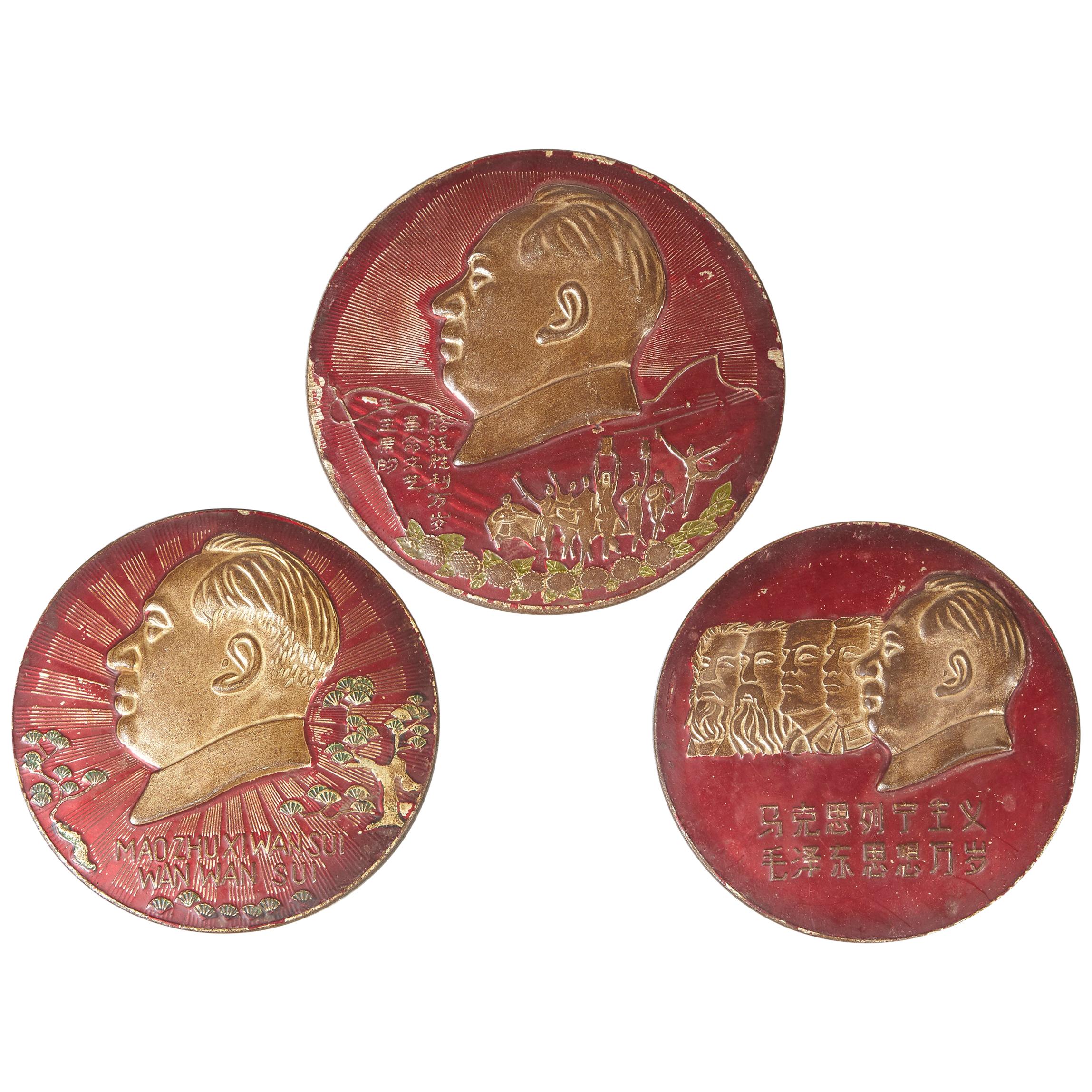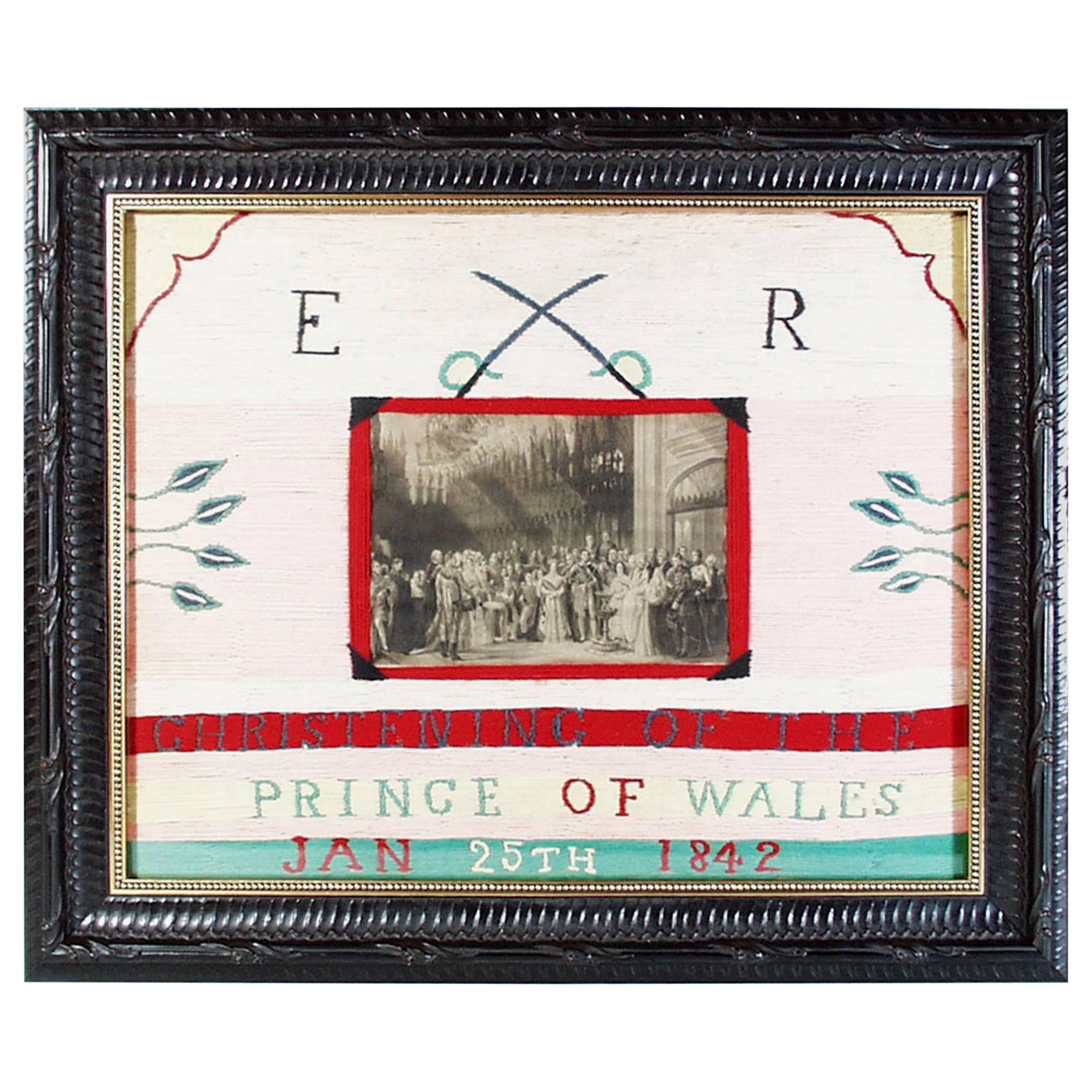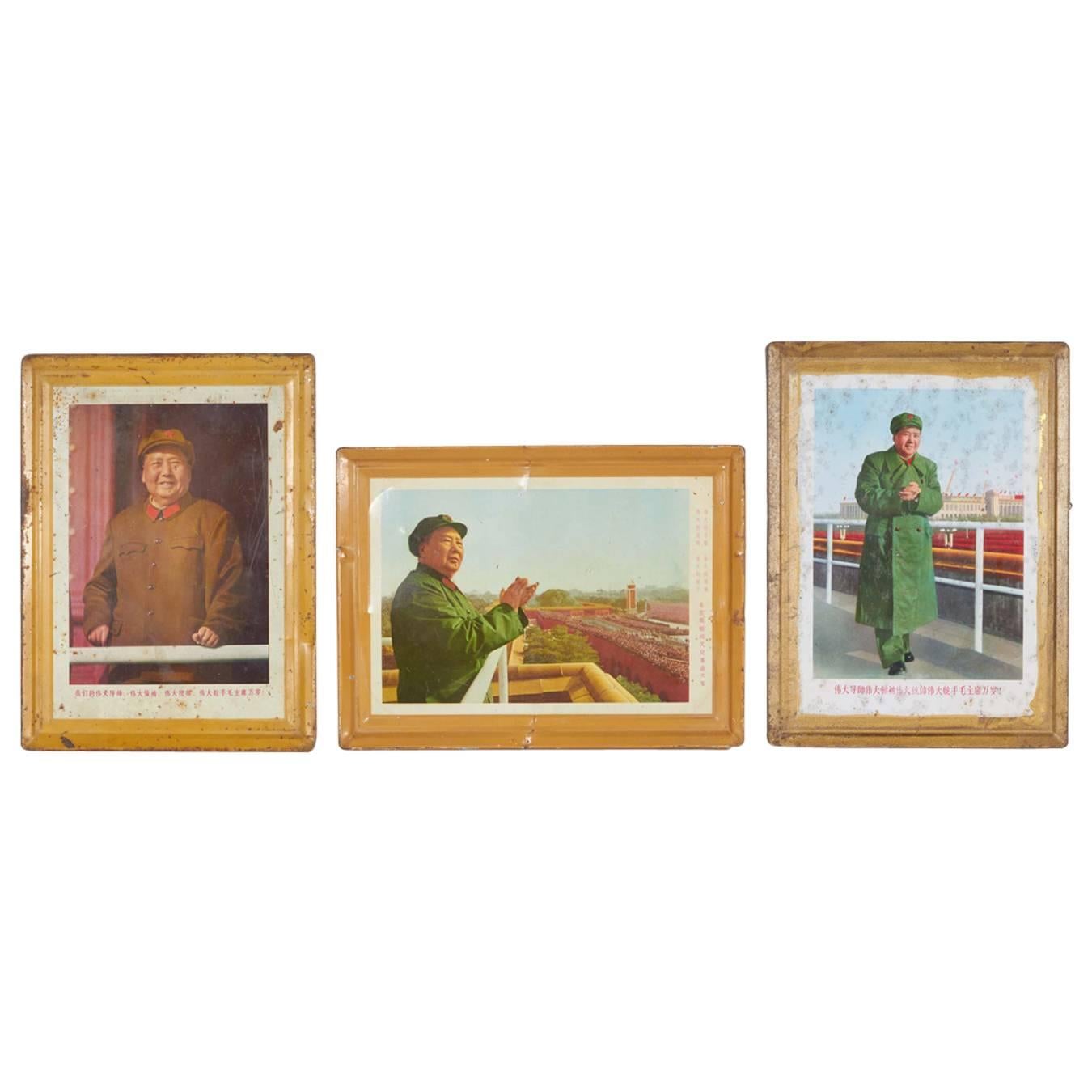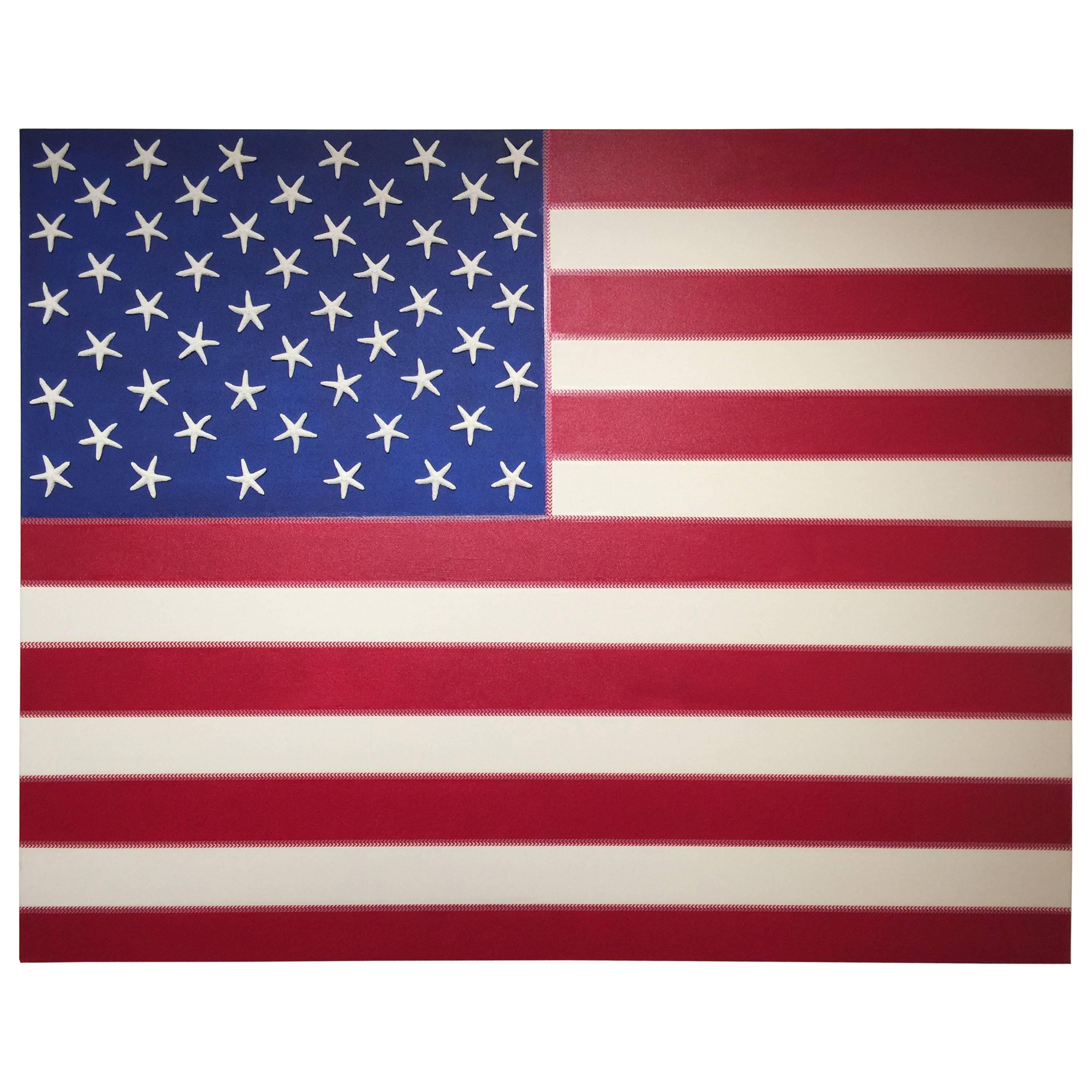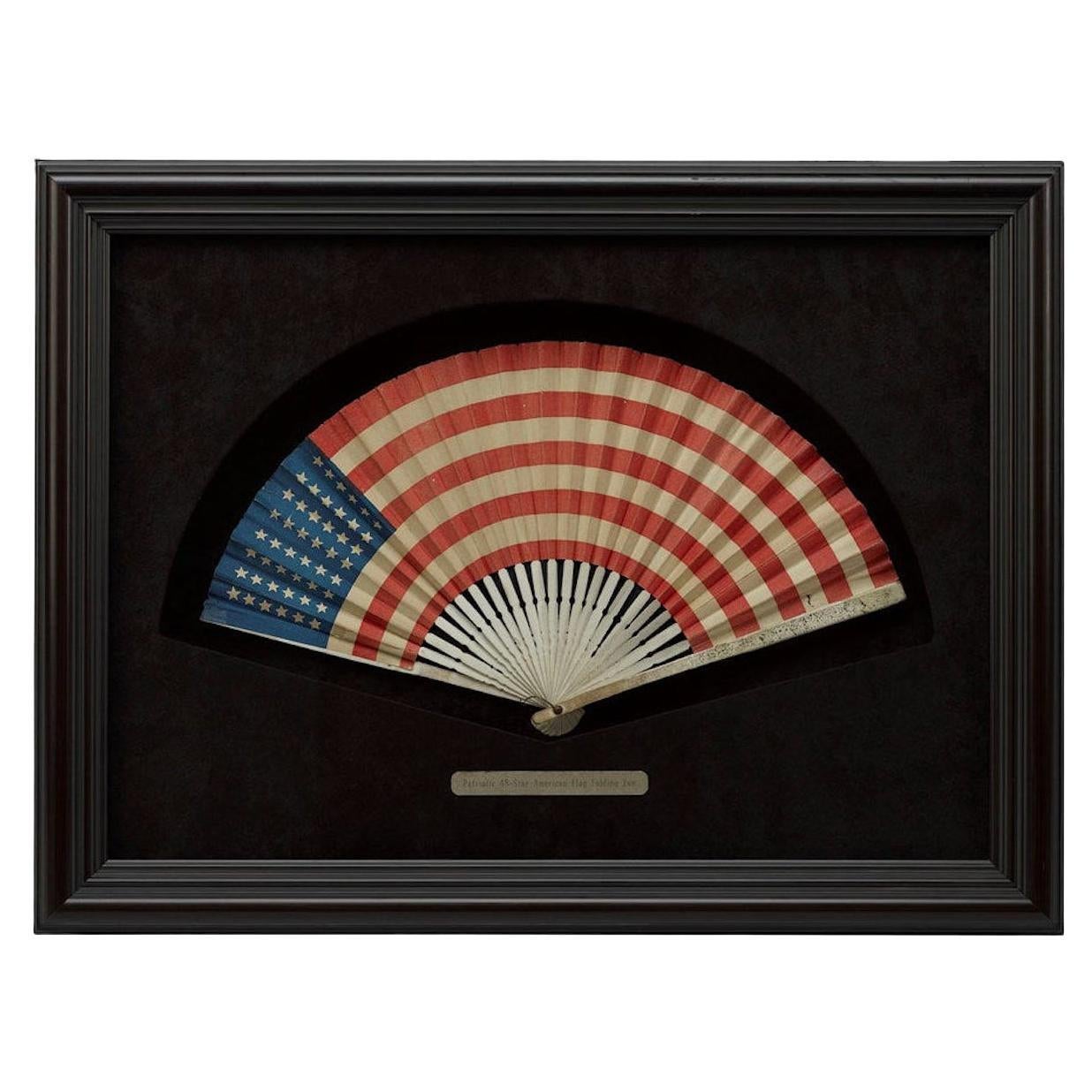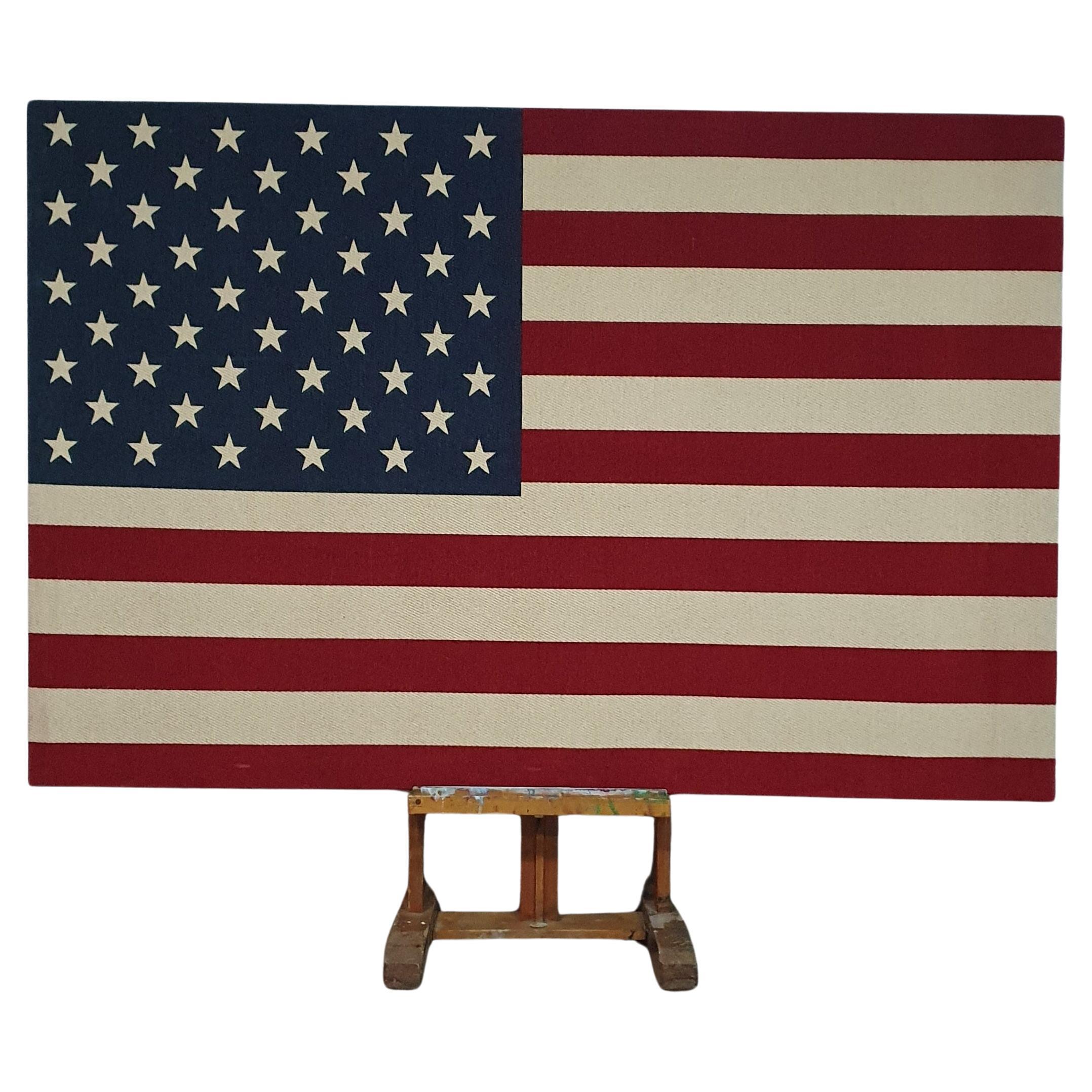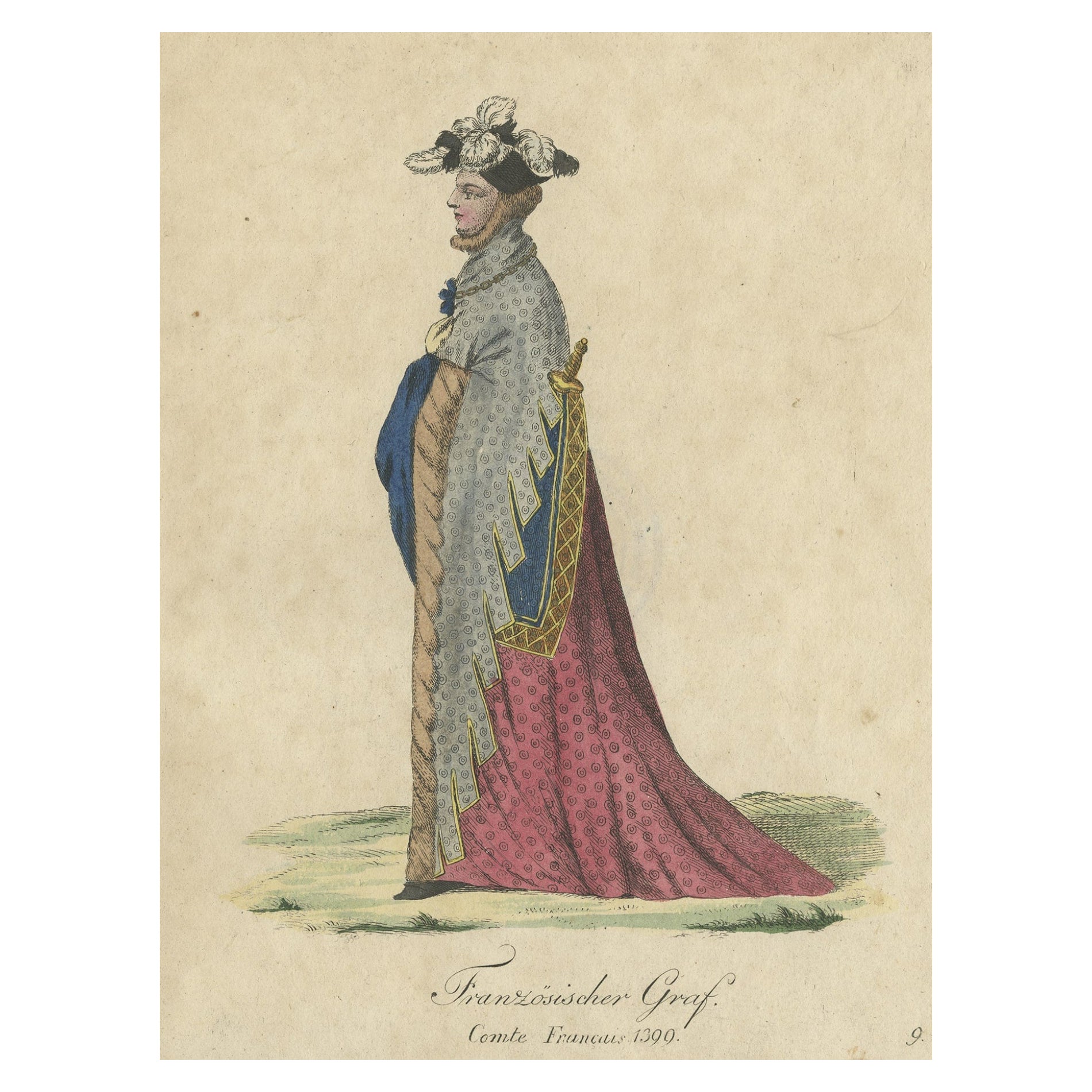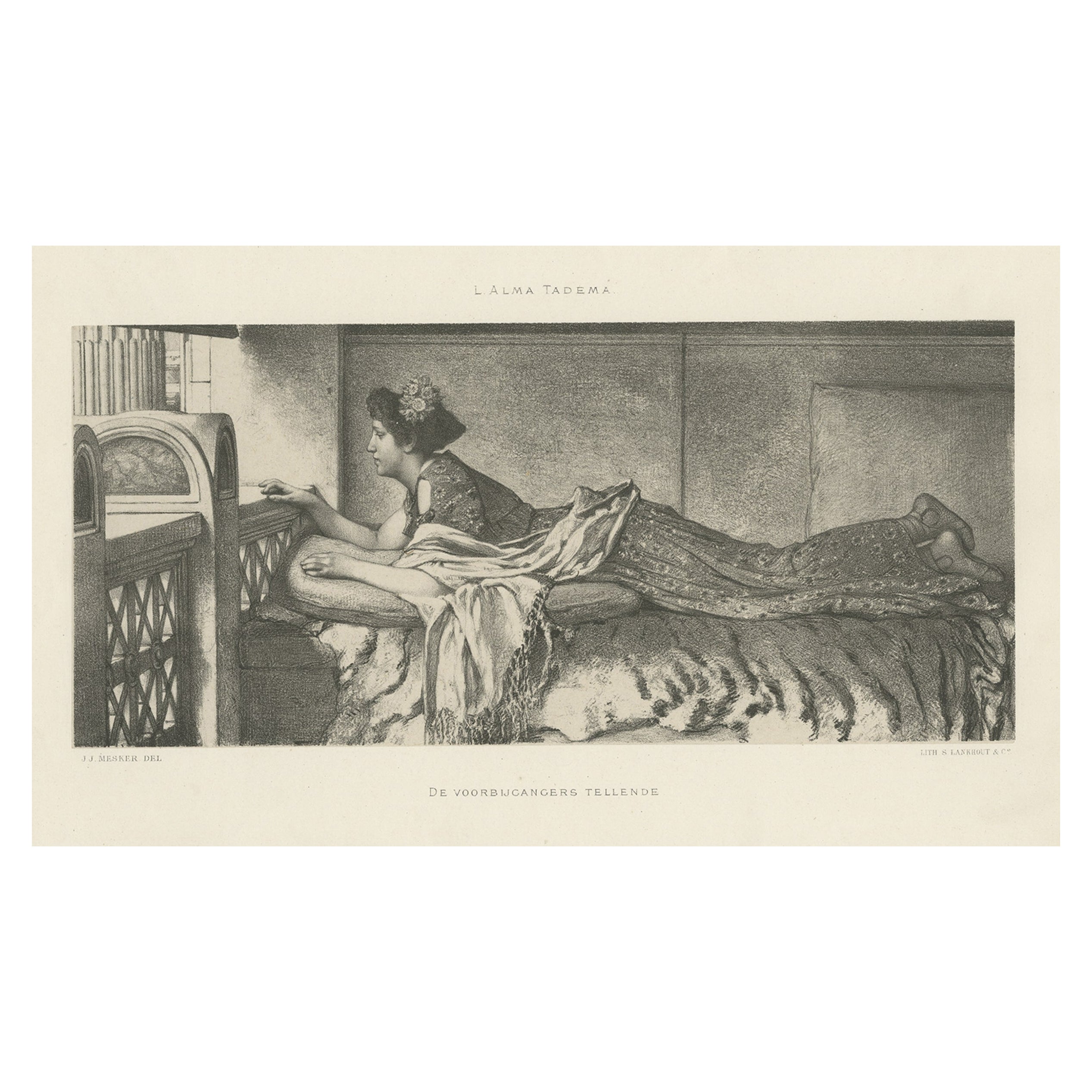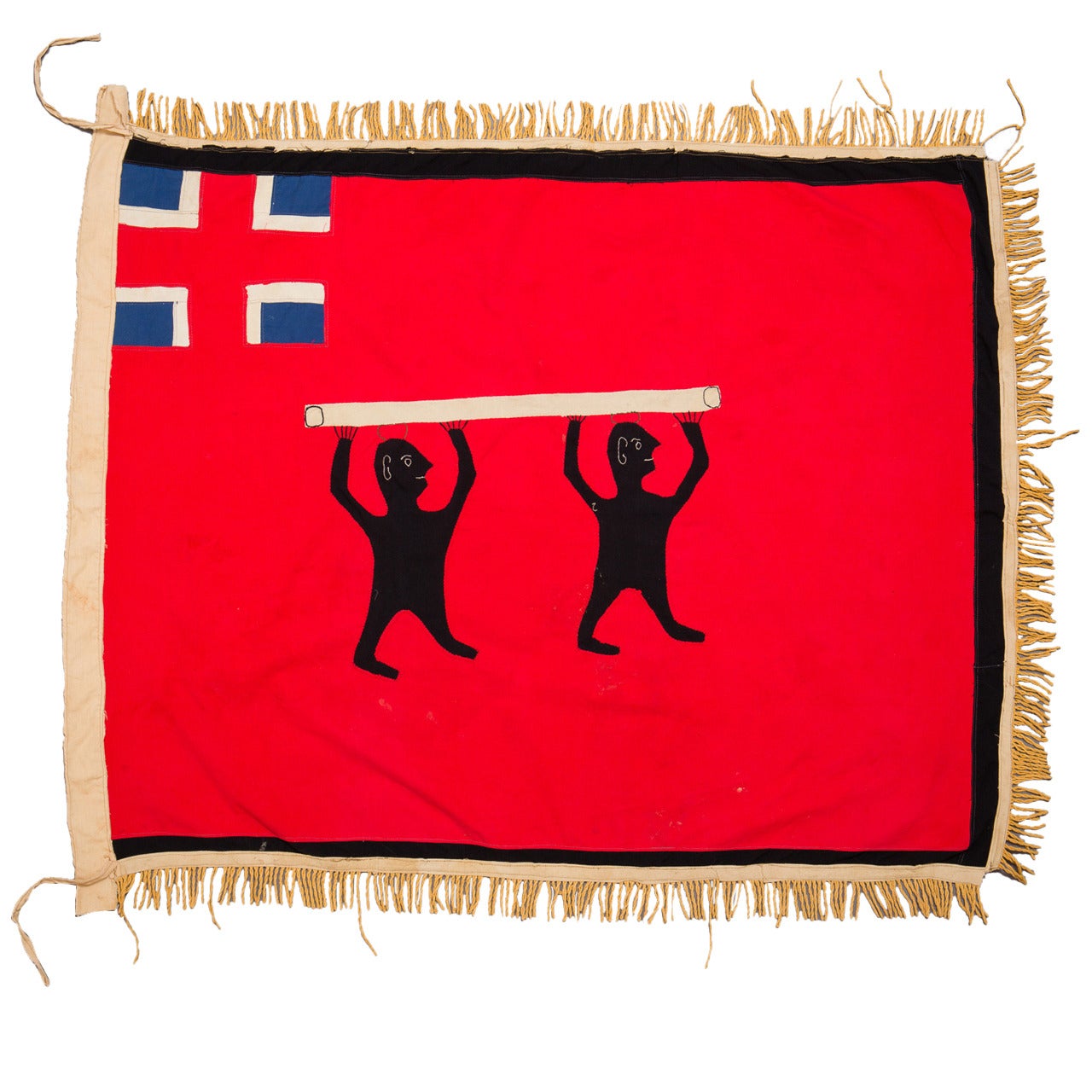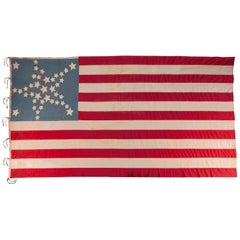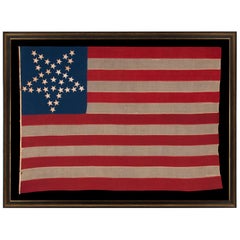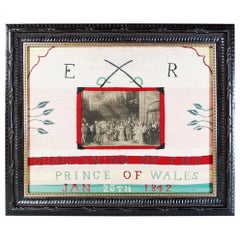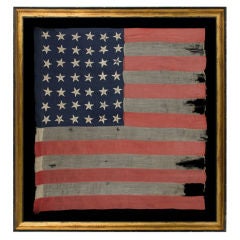
42 Stars, An Unofficial Star Count Flag
View Similar Items
Want more images or videos?
Request additional images or videos from the seller
1 of 5
42 Stars, An Unofficial Star Count Flag
About the Item
42 star American national flag, made in the 1889-90 period, probably for U.S. Army application as a cavalry standard. Smaller than a infantry battle flag, but in a square profile that bears some similarities, the basic form is distinctly military with a vertically-oriented, tall and narrow canton. The unfurled size is close to that of Civil War regulations for U.S. Cavalry colors. And unlike most wool flags that have survived from the 19th century, the pattern of wear and fabric loss in this flag represent extended use rather than moth damage. While the flag has no specific history, the above facts suggest that the flag may have been carried as a Indian War-era, U.S. cavalry battle flag.
During the Civil War and prior, most battle flags were made of silk and had gilt-painted stars. After the war, the choice of materials didn't change a great deal, but with the end of Reconstruction in 1876 came the beginning of a transitional era for the construction of flags for military ground forces. Many battle colors produced after that date are wool with appliquéd cotton stars, like this flag.
The 42 star flag is interesting from a historical perspective, both because 42 was never an official star count, and because 42 star flags were only produced for about 8 months (November, 1889 – July 4th, 1890). The flag represents the addition of the Dakotas, Montana and Washington State, between November 2nd and November 11th, 1889. The 42nd state was officially Washington, but the four states gained their statehood only nine days apart, and flag makers added four stars, accordingly, to the 38 star flag that was previously official.
After 1818, star counts became official on the 4th of July each year. A new star was therefore officially added on Independence Day for every state that had been added over the preceding “flag year”. Flag makers, however, did not wait for July 4th and official star counts. Flag making was a competitive industry, and no one wanted to be making 38 star flags, for example, when their competitors were making 42 star flags and there were 42 states. Idaho received statehood on July 3rd, 1890, taking the star count to 43 just one day before 42 would have become the official number. This fact makes 42 star flags an interesting part of our heritage and a classic display of American capitalism.
I have seen it at least one other military flag in this star count. I have never seen a square battle colors in the 42 star count, however, and I believe it to be a unique form in American flag collecting.
In addition to the rarity of the flag, note how the placement of the stars, which point in various directions on their vertical axis, adds an interesting folk quality. Together the wear, star positioning, color and patina result in a very attractive, 19th century flag.
Construction: The stripes and canton of the flag are made of wool bunting that has been joined with treadle stitching. The stars are made of cotton and double-appliquéd (applied to both sides) of the navy blue canton with a lineal treadle stitch. An open sleeve was created at the hoist end by turning over the stripes and canton onto themselves and finishing with a treadle-stitch.
Mounting: The flag is in the process of being mounted. Fabric of similar coloration was placed behind the red stripes and blue canton to mask losses. The white stripes were not backed, so as to show age and use. The flag will then be stitched to 100% organze for support on every seam and throughout the star field. The flag will then be hand-sewn to a background of 100% cotton, black in color, which was washed to reduce excess dye. An acid-free agent was added to the wash to further set the dye, which was heat-treated for the same purpose. The mount will then be placed in a black-painted, hand-gilded and distressed Italian molding. The glazing will be U.V. protective acrylic.
Condition: There is moderate to significant fabric loss throughout, particularly at the fly end and along the top. Almost half of the top stripe is absent, and this damage continues across the top edge of the canton. There is even significant wear on the stars, which is indicative of long-term heavy use. Many of my clients prefer early flags to show their age in an attractive manner.
- Place of Origin:
- Period:
- Date of Manufacture:1889-1890
- Condition:See Item Description.
- Seller Location:York County, PA
- Reference Number:Seller: 42-0251stDibs: U1112128497502
About the Seller
5.0
Recognized Seller
These prestigious sellers are industry leaders and represent the highest echelon for item quality and design.
Established in 1991
1stDibs seller since 2008
61 sales on 1stDibs
Typical response time: 10 hours
More From This SellerView All
- 34 Star American flag, Updated to 39 Stars, with Stars in a Great Star PatternLocated in York County, PA34 STARS IN A WHIMSICAL RENDITION OF THE GREAT STAR PATTERN, ON A CIVIL WAR PERIOD FLAG WITH A CORNFLOWER BLUE CANTON, UPDATED TO 39 STARS IN 1876 34 star American national flag with additional stars added and one of the most stunning graphic designs I have ever seen in early flag-making. The original pattern was comprised of a circle of 5 large stars, and triangular arms made of smaller stars. These are noticeable pointy and bent like the arms of a starfish. Made of cotton, the stars are hand-sewn and double-appliquéd to a fantastic, cornflower blue canton, a color common to Civil War uniforms...Category
Antique 1870s American Political and Patriotic Memorabilia
MaterialsCotton
- 38 Star Parade Flag with Whimsical 6-Pointed Stars, Colorado StatehoodLocated in York County, PA38 WHIMSICAL STARS, WITH 6-POINTED PROFILES, SIMILAR TO THE STAR OF DAVID, ON AN ANTIQUE AMERICAN FLAG OF THE CENTENNIAL ERA; A REMARKABLE SPECIMEN, ONE-OF-A-KIND AMONG KNOWN EXAMPLE...Category
Antique Late 19th Century American Political and Patriotic Memorabilia
MaterialsCotton
Price Upon Request - 36 Star Antique Flag, Nevada Statehood, with Stars in the "Great Star" PatternLocated in York County, PA36 STARS IN THE "GREAT STAR" OR "GREAT LUMINARY" PATTERN, ON A MERINO WOOL FLAG OF THE CIVIL WAR ERA WITH BEAUTIFUL SCARLET AND ROYAL BLUE COLOR AND WITH ITS CANTON RESTING ON THE "WAR STRIPE," REFLECTS NEVADA STATEHOOD, 1864-67 36 star antique American flag of the Civil War era, with some rare, desirable, and beautiful features. The most obvious of these is the configuration of the stars. These are arranged in what is known as the “Great Star” or "Great Luminary" pattern, a star made out of stars, which is one of the most graphic and desired geometric designs among flag enthusiasts. Nevada entered the Union as the 36th state on October 31st, Halloween, in 1864. Ushered in by Abraham Lincoln just eight days before the presidential election that resulted in his second term, the territory’s wealth in silver was attractive to a nation struggling with the debts of war and so increased support for the Republican ticket. The 36th star was officially added on July 4th, 1865, but since the flag makers generally cared very little about official star counts, the production of 36 star flags began much earlier. The makers of printed flags are known to have begun adding the 36th star as early as July of 1864, several months before the addition of Nevada actually occurred. This was a common practice during the late 19th century and is reflective of both the nation's desire for Westward Expansion and the hope of flag-makers to bring new star counts to market before their competitors. The 36 star flag was officially replaced by the 37 star flag in 1867, following the addition of Nebraska. Great Stars come in many forms. This particular example has a single center star, surrounded by a pentagon of 5 stars, set inside its star-shaped perimeter. Note how the Great Star is positioned with two points up instead of one and so is effectively upside-down with respect to modern convention. Unlike the current flag, versions of the Stars & Stripes made during the 19th century and prior often displayed stars that were varied or completely random in their rotation on a vertical axis. Note how the feature draws attention and is unusual to the eye, in addition to being visually appealing. Another interesting trait can be seen in the fact that the canton rests on a red stripe. When this scarce condition occurs, some flag historians have referred to it as the “blood stripe” or the “war stripe”, suggesting the flag was constructed in this manner when the nation was at war. In actuality, the placement probably occurred more often by accident. Not everyone knew where the canton was traditionally positioned, and because there was no official specification until 1912, there was no official placement. Whatever the case may be with regarding the reason, the war stripe feature is highly coveted by collectors. The stars of the flag are hand-sewn, made of cotton, and are double-appliquéd (applied to both sides). The canton and stripes of the flag are made of fine merino wool. These are beautiful, luxurious fabrics with strong royal blue and scarlet color. Every seam was joined with a row of hand-stitching, then finished with a row of treadle stitching. Instead of employing the selvage edge of the red fabric, the top and bottom edges of the flag were turned under and seamed by hand and the fly end was seamed in the same fashion. There is a narrow binding along the hoist, treadle-sewn and made of cotton. Along this five cotton tabs were affixed, each with a tiny brass ring, which suggests that the flag was probably affixed to a wooden staff with twine or ribbon and hand-carried. The name of "Stow" is inscribed along the hoist. This would be the name of a former owner. In the field of early American flags...Category
Antique 1860s American Political and Patriotic Memorabilia
MaterialsWool
- 33 Star Flag with Stars in a "Great Star" Pattern, Oregon State, ca 1859-1861Located in York County, PA33 STARS IN A "GREAT STAR" PATTER ON A BRILLIANT, ROYAL BLUE CANTON, A RARE AND EXTRAORDINARY EXAMPLE, PRE-CIVIL WAR THROUGH THE WAR'S OPENING YEAR, 1859-1861, OREGON STATEHOOD 33 s...Category
Antique Mid-19th Century American Political and Patriotic Memorabilia
MaterialsSilk
- 38 Star American Flag, Stars in Notched Pattern, ca 1876-1889Located in York County, PA38 HAND-SEWN STARS IN A "NOTCHED" PATTERN, ON AN ANTIQUE AMERICAN FLAG WITH BEAUTIFUL WEAR FROM HAVING BEEN EXTENSIVELY FLOWN, MADE AT THE TIME WHEN COLORADO WAS THE MOST RECENT STATE TO JOIN THE UNION, 1876-1889 38 star Antique American flag, made during the period when Colorado was the most recent state to join the Union. The stars are arranged in what is known as a "notched" pattern, in which two spaces were left open along the hoist end, in the first and last rows, in anticipation that two more Western Territories would soon join the Union. The latter 19th century was a time of when much of the land in and about the Continental Divide was formalized into states, and there was continual speculation about which ones would be accepted next, and with what boundaries. The stars of the flag are made of cotton and are double-appliquéd (applied to both sides) with a lineal, treadle stitch. The canton and stripes of the flag are made of wool bunting that has been pieced with treadle stitching. The canton was constructed from five separate lengths of fabric, which is an unusual feature, though hardly unknown. To each of these a row of stars was sewn. This manner of construction is sometimes encountered and tends to be an early trait, at least when it occurs in flags of this scale and smaller. When encountered, it also seems to have been preferred in flags meant for maritime use. While the feature does not by any means guarantee this fact, it is a reasonable, educated guess, based upon my examination of many other examples. A flag with a 5-piece canton, such as this, would have been less likelihood to stretch, with increased structural integrity. The alternative is that this was simply an example made when there were at least five pieces of leftover fabric, of a reasonable size to made individual rows, and that what it actually demonstrates is the careful conservation of scarce resources. There is a sailcloth canvas binding along the hoist, with 3 brass grommets, evenly spaced. Perhaps the best feature of the flag is the evidence it displays of having been extensively flown, with the fly end whipped out from wind exposure. While many flags display damage from a combination of having been flown, exposure to the elements, various mishaps, and improper storage, very few exhibit wear such as this, which is both endearingly and visually attractive. This one shows its age beautifully, whipped out along the fly end, with losses that convey an element of movement, that most flags don’t capture in the state in which they survive. Colorado became the 38th state on August 1st, 1876. This was the year of our nation’s 100-year anniversary of independence. Per the Third Flag Act of 1818, stars were not officially added until the 4th of July following a state's addition. For this reason, 37 was the official star count for the American flag in 1876. Flag-making was a competitive venture, however, and few flag-makers would have been continuing to produce 37 star flags, when their competitors were making 38’s. It is for this reason that 38 and 13 stars (to represent the original 13 colonies...Category
Antique Late 19th Century American Political and Patriotic Memorabilia
MaterialsWool
Price Upon Request - 42 Star Antique American Parade Flag, Ca 1889-1890Located in York County, PA42 STARS ON AN ANTIQUE AMERICAN FLAG WITH SCATTERED STAR POSITIONING, REFLECTS THE ADDITION OF WASHINGTON STATE, MONTANA, AND THE DAKOTAS, NEVER AN OFFICIAL STAR COUNT, circa 1889-18...Category
Antique Late 19th Century American Political and Patriotic Memorabilia
MaterialsCotton
Price Upon Request
You May Also Like
- Three Embossed Metal Cultural Revolution Plaques with Images of MaoLocated in New York, NYThree cultural revolution period embossed metal plaques, each with the image of Chairman Mao, one plaque also including images of the leaders of Russian communism. Priced and sold ...Category
Late 20th Century Chinese Decorative Art
MaterialsMetal
- Christening of the Prince of Wales Woolwork Picture, Dated 1842Located in Downingtown, PAEnglish Royal Woolwork Picture, Titled E R/ Christening of the/Prince of Wales/Jan 25th 1842. A rare woolwork picture in bands of white, pink, red and green centered with a black and white picture...Category
Antique Mid-19th Century English Folk Art Decorative Art
MaterialsWool
- Set of Mao Cultural Revolution Portraits on TinLocated in New York, NYA set of three small striking Mao cultural revolution portraits on tin. Great historical pieces, China, circa 1960s. P394a.Category
Vintage 1960s Chinese Decorative Art
MaterialsTin
- J. WOHNSEIDLER American Flag No. 1, 2017 Acrylic on CanvasLocated in New York, NYAmerican Flag No. 1 by J. Wohnseidler. Arcylic on canvas with hand-applied starfish. Unframed. Signed/titled/dated by artist on back. Measures: 48 inches L x 36 inches H x 1.5 inches D.Category
2010s American Contemporary Art
MaterialsCanvas, Acrylic
- Patriotic 48-Star American Flag Folding FanLocated in Colorado Springs, COPresented is a printed folding fan featuring the American Flag, which dates to the early 20th century. With 48 printed stars on the fan’s canton, the fan celebrates New Mexico and Arizona statehood. The fan’s design is completed with 13 alternating red and white stripes across its white sticks and guard. The 48-star flag had a fly date of 47 years, from July 4, 1912 to July 3, 1958. Prior to the introduction of the 48-star flag with the admission of New Mexico and Arizona to the Union in 1912, no legislation existed regarding the official proportions, sizes, and pattern for stars on the American flag. As a result, many Americans designed the starry canton of their homemade flags to their own whim, in medallion, spiral, and flower star configurations. Coinciding with the introduction of the 48 star flag in 1912, President William Howard Taft...Category
Early 20th Century Decorative Art
MaterialsPaper
- Large American woven silk flag / stars and stripes / assembled a wooden frameLocated in WEERT, NLAmerican woven silk flag / stars and stripes / assembled on a wooden frame Wide 193 cm Height 130 cm Depth 2.5 cm The woven silk flag will be shipped disassembled in a cardboard tubeCategory
Vintage 1980s Unknown Other Decorative Art
MaterialsFabric, Beech
Recently Viewed
View AllMore Ways To Browse
42 Star Flag
43 Star Flag
Black Votes
Antique American Flag 49 Stars
Chinese Porcelain Lunch Box
Silk Embroidery Eagle
Chief Tecumseh
Japanese Wwii Flag
American Plaque Centennial 1876
Antique Flags Kansas
Illinois Molding Company
Civil War Era Clothing
Mason And Hamlin
Toy Singer Sewing Machine
Vote Democrat Quilt
Buermann Spurs
Carved Wood Bears
E H Rigg
